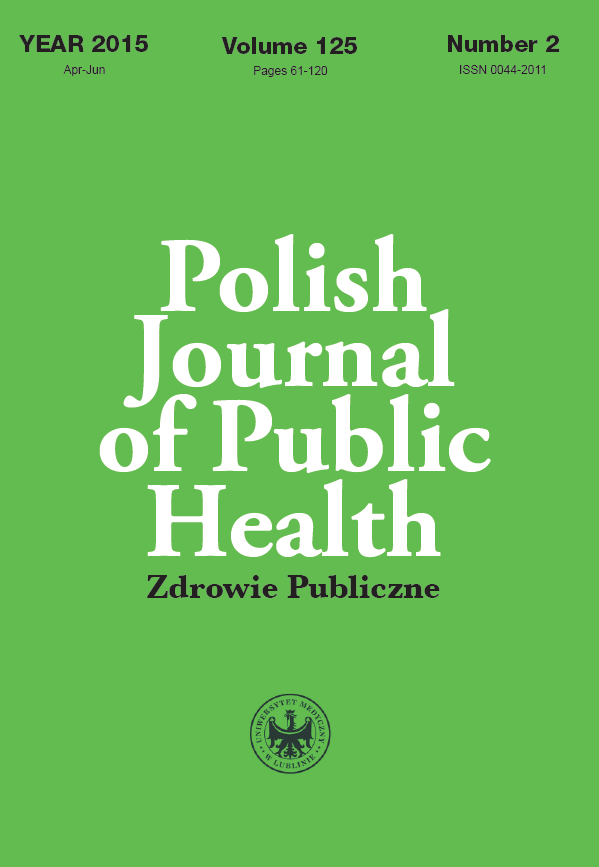Stress and methods of coping with it among students of the Medical University of Lublin
DOI:
https://doi.org/10.1515/pjph-2015-0032Keywords:
stress, stressor, reaction to stress, symptoms of stressAbstract
Introduction. Stress is a complex and ubiquitous phenomenon. According to the World Health Organization, it is one of the most common problems of the 21st century. It is no surprise that the majority of people associate stress with something entirely negative. However, there is no life without stress and a certain amount of stress in life is necessary.
Aim. The aim of the study was to assess the occurrence of stress among students of the Medical University from the faculties of Medicine, Pharmacy, Dentistry and Public Health, and evaluate its influence on physiological changes and behavior, and present the ways of coping with it.
Material and methods. The study comprised 240 students from the faculties mentioned above. Stress was measured by means of a questionnaire consisting of 14 fully anonymous questions which concerned factors causing stress, ways of reacting to it and methods of coping with it.
Results. It was found out that stress as an intense emotional reaction to a number of stimuli triggers some physiological and psychological adaptation responses among students.
Conclusions. The findings of this research suggest that pharmacy students are the most exposed to high levels of stress. Oral examination is considered to be the most stressful form of testing students’ knowledge. According to survey respondents, the most common symptoms of stress include abdominal pain palpitations, sleep disorders, excessive sweating, hand shaking. The majority of respondents listed the following activities to beat stress: sports, sleeping or listening to music, as most effective in reducing stress. Some of the respondents also turned to substances, such as tobacco or alcohol. The respondents admitted that they have also used drugs.
References
1. Ziemska B, Marcinkowski JT. Badania nad stresem psychicznym związanym ze studiami medycznymi. Now Lek. 2008;77(2):120-5.
2. Marcinkowska U, Lau K, Jośko-Ochojska J. O potrzebie kształcenia studentów medycyny w aspekcie wiedzy o stresie w ramach zajęć fakul¬tatywnych. Hygeia Public Health. 2013;48(2):152-5.
3. Landowski J. Stres a zaburzenia psychiczne. Przew Lek. 2003;80(3):80-5.
4. Wons A. Stres i radzenie sobie ze stresem. In: A. Trzcieniecka-Green (ed). Psychologia. Podręcznik dla studentów kierunków medycznych. Kraków: Wydawnictwo Universitas;2006.
5. Piątkowski W. Stres i formy jego przezwyciężania – aktywność fizyczna i wypoczynek. In: Z. Kawczyńska-Butrym (ed). Uczelnia promująca zd¬rowie. Lublin; 1995.
6. Zołnierczuk-Kieliszek D. Stress and methods of dealing with it among the students of the Faculty of Medicine of Medical University in Lublin. Annales Universitatis Mariae Curie-Sklodowska. Sectio D: Medicina. 1999;54:227-33.
7. Rosołowska J. Przyczyny stresu u studentów Wydziału Nauk o Zdrowiu Akademii Medycznej w Poznaniu. Piel Pol. 2003;1(15):82-3.
8. Chrzanowska D, Wdowiak L, Bojar I. The origin of stress, its causes, symptoms and frequency of appearance among the students of Medical University of Lublin. Annales Universitatis Mariae Curie-Sklodowska. Sectio D: Medicina. 2004;59(1):438-43.
Downloads
Published
Issue
Section
License
Copyright (c) 2015 Polish Journal of Public Health

This work is licensed under a Creative Commons Attribution-NonCommercial-NoDerivatives 3.0 Unported License.


